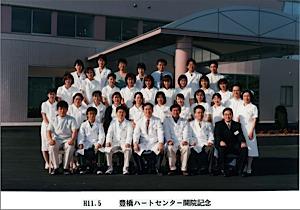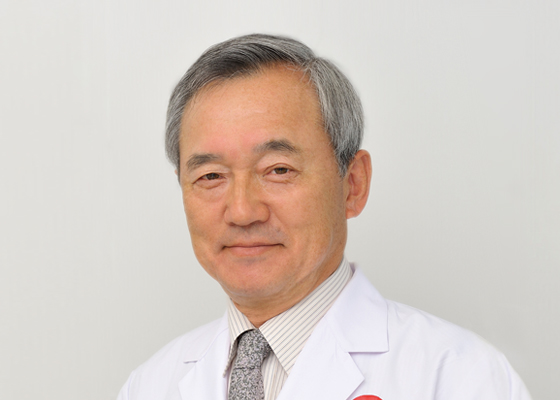Though there have been a lot of PCI clinics opening recently, they're neither easy to develop nor expand. PCI cannot solve everything, and the practice of surgery is still important. Going without it imposes restrictions in many ways, for example, in cases of calcified lesions where the stent does not expand sufficiently, a rotablator is needed, but when faced with a case of perforation without access to a surgical department, you are limited to your PCI technique. In order for a PCI clinic to be successful, we may need to show our other characteristics.
What was the most difficult part of opening a heart center?
Opening any business is quite an undertaking, so there were many difficulties. About a year before we opened, Dr. Ohkawa, Mr. Shirakawa (the previous office manager), and I had made the decision to build a Heart Center based on our shared ideals but, of course, running a hospital requires a lot of money. We had to get a loan from the bank but since the amount of money involved was so considerable, they required not only my name but also a co-signer. My wife, Dr. Okawa, and Mr. Shirakawa were among the guarantors, but when the time came, I still needed one more name. We were worried that we wouldn't be able to secure the loan, so we contacted Dr. Hayase, who was studying in the U.S. at the time, and he gladly accepted our request.
Another problem was attaining the title of "Heart Center". We started our business with 19 beds and it's more common in those instances to refer to yourselves as a clinic. The doctors of the surrounding hospitals were very considerate of us in this regard.
There were many other hardships as well, but I think these were the two most memorable events. In both cases, I felt the warmth of the people very deeply. The Toyohashi Heart Center couldn't have started without the cooperation of these people.
 Toyohashi Heart Center Opening Commemoration
Toyohashi Heart Center Opening Commemoration
And what was the best part?
There are so many to choose from. It was a lot of hard work, but there was also a lot of joy. And I still feel that joy today. I created the Heart Center with the aim of providing high-quality medical care at a reasonable price, which only a private specialty hospital can do. It's wonderful to be able to freely share so many ideas with my colleagues. Sometimes, the waiting times are long and the diagnostic process including the interview can be short, but we take care to communicate fully with our patients from catheterization all the way through to treatment in order to overcome any negative image our patients may have.
Also, since we're a private hospital, we're free to put any profits we earn back to society. Every year on August 10th, which is designated as Heart Day, we hold a volunteer activity at the Hotel near our center with the help of our staff and other companies. Recently, I've also made an effort to make people feel closer to heart disease by donating AEDs to Toyohashi City. It's one of my joys to be able to help society this way.
What do you think Toyohashi Heart Center will be like in 10 years? What are your goals?
Compared to when the Heart Center first opened, the number of patients has increased by 20-30%. Considering the region, that number of patients is unlikely to increase any more in the future, so for my next step I would like to focus on improving the quality of medical care by being more active in research. Recently, we have started to focus on areas such as EPS and ablation as well as PCI. Our next goal is to provide our patients with the best medical care available at that point in time. Currently, we have excellent interventionists from all over Japan who are coming together to make our facility a place where medical advances can be shared with the world.
As both a successful cardiologist and business owner, what advice would you like to pass on to other cardiologists who are now planning to start their own businesses?
Firstly, the job of a cardiologist is very different to that of a business owner. People who are successful as doctors are not necessarily successful as managers. Today, Japan has a system that easily allows people to open their own businesses, but that doesn't mean that if you open a business, you can automatically become a manager. A manager has to develop his or her business. A clinic without a catheter room is different from a facility of any size that has a catheter room with several people. Having a cath lab requires hospital management which can be difficult. In our facility, we have more than 20 doctors. The difference between running a hospital and a clinic without a cath lab is how you train the doctors and other staff members. In hospital management, the scope of what you can do is limited. It's the manager who can make or break the staff. If you cannot make good use of your staff, you will not be able to run a hospital. It is also vital that you and your staff share the same goals.
The best advice I can give to doctors who are thinking of opening and running their own hospital in the future is that they should start with a business that is tailored to their abilities. Do not start a business that is beyond your current capacity. It's far better to start with a business that is smaller but has the potential for growth. Business is about perpetuity and should not be thought of as a one-and-done deal. If a child were to try riding a bicycle for adults, the pedals would be too heavy and the handlebars too hard to operate, causing it to fall over. But if the child rides a tricycle, there's no danger of falling, and it's only when they're able to ride around on that that they can move on to a slightly larger bike. The most important thing is not to rush, but to assess yourself and manage your business accordingly.
Interviewed in 2006







